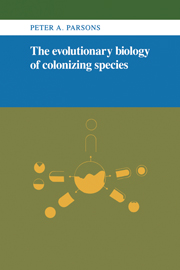Book contents
- Frontmatter
- Contents
- Preface
- 1 Introduction: Colonists and habitats
- 2 Genetics and ecology
- 3 Physical conditions, resources, and ecological phenotypes
- 4 Variability in natural populations
- 5 Genetic variability, ecological phenotypes, and stressful environments
- 6 Colonizing phenotypes and genotypes
- 7 Behavioral variability in natural populations
- 8 Habitat selection
- 9 The ecobehavioral phenotype: generalists and specialists
- 10 The ecobehavioral phenotype: biological control and domestication
- 11 Parasites and plants
- 12 Discussion and conclusions
- Appendix The study of quantitative traits
- References
- Index
12 - Discussion and conclusions
Published online by Cambridge University Press: 15 September 2009
- Frontmatter
- Contents
- Preface
- 1 Introduction: Colonists and habitats
- 2 Genetics and ecology
- 3 Physical conditions, resources, and ecological phenotypes
- 4 Variability in natural populations
- 5 Genetic variability, ecological phenotypes, and stressful environments
- 6 Colonizing phenotypes and genotypes
- 7 Behavioral variability in natural populations
- 8 Habitat selection
- 9 The ecobehavioral phenotype: generalists and specialists
- 10 The ecobehavioral phenotype: biological control and domestication
- 11 Parasites and plants
- 12 Discussion and conclusions
- Appendix The study of quantitative traits
- References
- Index
Summary
There is no such thing as a sharp separation between genetics, ecology, the study of behavior, and still other ways of looking at colonizers. I am sure every ecologist here realizes that he really ought to know more about genetics, that in a way he should consider the genetics of his organisms as part of their ecology. In a similar fashion, the geneticists realize that they cannot truly understand many of the genetic phenomena accompanying colonization unless they study them on the background of the ecological situation, again demonstrating there is no clear division between the two fields. In animals the study of behavior is quite clearly, in all cases, a third dimension to this same picture.
[Mayr, 1965:561–2]Too often, the adaptationist programme gave us an evolutionary biology of parts and genes, but not of organisms.
[Gould and Lewontin, 1979]The organism as the unit of selection
The overriding assumption of this book is that the organism is the unit of selection. The organism can be considered as a behavioral phenotype, ecological phenotype, metabolic phenotype, electrophoretic phenotype, biochemical phenotype, physiological phenotype, morphological phenotype, and so forth according to the emphasis. Since this book is on colonizing species and their habitats, the ecobehavioral phenotype including life-history components dominates. The compound term ecobehavioral emphasizes the difficulty of separating ecological and behavioral components in the determination of habitats.
The real world is much more complex than envisaged by those who consider that evolution is merely a question of how the best alleles in all loci come to be assembled.
- Type
- Chapter
- Information
- The Evolutionary Biology of Colonizing Species , pp. 206 - 219Publisher: Cambridge University PressPrint publication year: 1983



